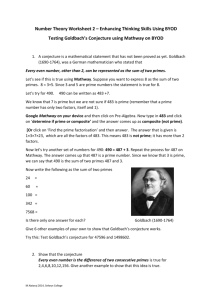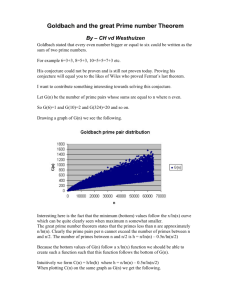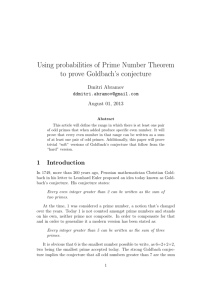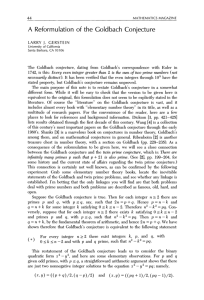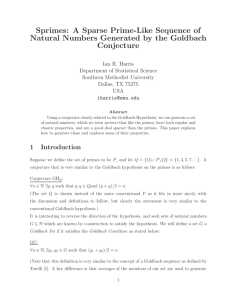Get - Wiley Online Library
advertisement
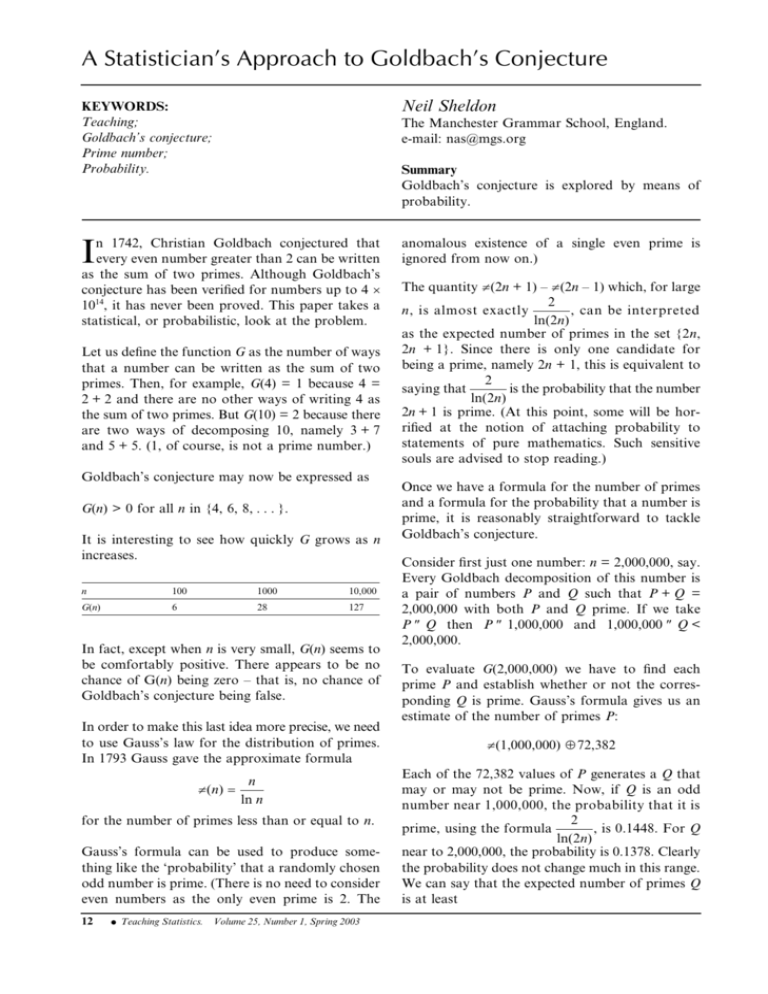
A Statistician’s Approach to Goldbach’s Conjecture
Blackwell
Oxford,
Teaching
TEST
©
100141-982X
25
2002
Original
00Teaching
UK
Article
Statistics
Publishing
Statistics Ltd
Trust 2001
KEYWORDS:
Teaching;
Goldbach’s conjecture;
Prime number;
Probability.
Neil Sheldon
n 1742, Christian Goldbach conjectured that
every even number greater than 2 can be written
as the sum of two primes. Although Goldbach’s
conjecture has been verified for numbers up to 4 ×
1014, it has never been proved. This paper takes a
statistical, or probabilistic, look at the problem.
anomalous existence of a single even prime is
ignored from now on.)
The Manchester Grammar School, England.
e-mail: nas@mgs.org
Summary
Goldbach’s conjecture is explored by means of
probability.
I
Let us define the function G as the number of ways
that a number can be written as the sum of two
primes. Then, for example, G(4) = 1 because 4 =
2 + 2 and there are no other ways of writing 4 as
the sum of two primes. But G(10) = 2 because there
are two ways of decomposing 10, namely 3 + 7
and 5 + 5. (1, of course, is not a prime number.)
Goldbach’s conjecture may now be expressed as
G(n) > 0 for all n in {4, 6, 8, . . . }.
It is interesting to see how quickly G grows as n
increases.
n
100
1000
10,000
G(n)
6
28
127
In fact, except when n is very small, G(n) seems to
be comfortably positive. There appears to be no
chance of G(n) being zero – that is, no chance of
Goldbach’s conjecture being false.
In order to make this last idea more precise, we need
to use Gauss’s law for the distribution of primes.
In 1793 Gauss gave the approximate formula
π ( n) =
n
ln n
for the number of primes less than or equal to n.
Gauss’s formula can be used to produce something like the ‘probability’ that a randomly chosen
odd number is prime. (There is no need to consider
even numbers as the only even prime is 2. The
12
• Teaching Statistics.
Volume 25, Number 1, Spring 2003
The quantity π (2n + 1) – π (2n – 1) which, for large
2
n , is almost exactly
, can be interpreted
ln(2n)
as the expected number of primes in the set {2 n,
2n + 1}. Since there is only one candidate for
being a prime, namely 2n + 1, this is equivalent to
2
saying that
is the probability that the number
ln(2n)
2n + 1 is prime. (At this point, some will be horrified at the notion of attaching probability to
statements of pure mathematics. Such sensitive
souls are advised to stop reading.)
Once we have a formula for the number of primes
and a formula for the probability that a number is
prime, it is reasonably straightforward to tackle
Goldbach’s conjecture.
Consider first just one number: n = 2,000,000, say.
Every Goldbach decomposition of this number is
a pair of numbers P and Q such that P + Q =
2,000,000 with both P and Q prime. If we take
P ≤ Q then P ≤ 1,000,000 and 1,000,000 ≤ Q <
2,000,000.
To evaluate G(2,000,000) we have to find each
prime P and establish whether or not the corresponding Q is prime. Gauss’s formula gives us an
estimate of the number of primes P:
π (1,000,000) ≈ 72,382
Each of the 72,382 values of P generates a Q that
may or may not be prime. Now, if Q is an odd
number near 1,000,000, the probability that it is
2
prime, using the formula
, is 0.1448. For Q
ln(2n)
near to 2,000,000, the probability is 0.1378. Clearly
the probability does not change much in this range.
We can say that the expected number of primes Q
is at least
72,382 × 0.1378 ≈ 9978
And, assuming independence, we can also say that
the probability that none of the Q is prime is at
most
(1 – 0.1378)
72,382
≈ 10
–4663
easy to prove – has only a very tiny effect on the
subsequent probabilities.)
Finally, consider the sequence of blocks of numbers:
2 × 106 to 2 × 107, 2 × 107 to 2 × 108,
2 × 108 to 2 × 109, . . .
So a conservative estimate of the probability that
Goldbach’s conjecture fails for n = 2,000,000 is
astonishingly small: less than 1 in 104663.
The probabilities that Goldbach’s conjecture fails
in these blocks, calculated conservatively as above,
are:
It is now a simple matter to extend the argument
from a single number to a block of numbers. Let
us investigate the probability that Goldbach’s
conjecture fails for some number in the range
2,000,000 to 20,000,000.
10–4656, 10–34,100, 10–261,000, . . .
Again being conservative, we can say that the
probability of failure is no greater than
1 – (1 – 10–4663)(10,000,000–1,000,000)
≈ (10,000,000 – 1,000,000) × 10–4663
≈ 10–4656
because there are (10,000,000 – 1,000,000) even numbers to test and each has a probability of 10 –4663 or
less of causing Goldbach’s conjecture to fail. This,
again, is a very small probability.
(A more sophisticated analysis would take into
account the fact that, when n is a multiple of 6,
G(n) is, on average, twice as big as it is when n is
not a multiple of 6. This curious result – which is
So the probability that Goldbach’s conjecture fails
for some n > 2 × 106 is
1 – (1 – 10–4656)(1 – 10–34,100)(1 – 10–261,000) . . .
≈ 10–4656 + 10–34,100 + 10–261,000 + . . .
≈ 10–4656
Now, it is quite arbitrary that this argument began
at n = 2,000,000. Goldbach’s conjecture has been
verified up to n = 4 × 1014. With that starting
point, we obtain the probability that Goldbach’s
conjecture fails for some n > 4 × 1014 as roughly
10–150,000,000,000.
This probability is 1 in a million million million
. . . , where you have to say ‘million’ 25,000,000,000
times. At a reasonable rate of three words per
second that would take about 264 years – almost
exactly the length of time that has elapsed since
Goldbach first made his conjecture.
Teaching Statistics.
Volume 25, Number 1, Spring 2003 •
13
